#HES MY FAVORITE HIS SPEECH ARC RESEMBLES MINE SO CLOSELY
Explore tagged Tumblr posts
Text
Your silent protagonist doesn't have to use sign language btw. They don't have to write things down, either. They don't have to use language at all. Not every single person who doesn't talk can use words the same as you, or use them at all, so your favorite silent character shouldn't have to use what you consider a grammatical language to communicate in your fanart and fics. AAC exists. Drawing exists. Gestures and body language exist. Btw.
#i said ''your silent protagonist'' bc i feel like that'd hit close with the most people but i truly mean anyone that doesn't talk#ive seen it happen SO MANY TIMES its like ''this character never uses oral words'' and every post about them ignores it or uses sign#or they already have their own language or their language difficulties have been addressed and it STILL HAPPENS. like cassandra cain#who's like me.#inumaki toge#link#link loz#loz#legend of zelda#trainer red#champion red#red pokemon#HES MY FAVORITE HIS SPEECH ARC RESEMBLES MINE SO CLOSELY#pokemon rgby#pokemon hgss#ik sun/moon and usum are there too. so many tags#controversial one here probably but#chell#portal#cass cain#cassandra cain#batgirl#batman#fandom ableism#:)))))))))))#NOT AN EXAMPLE BC IT'S LITERALLY THE COMICS WHO MADE HIM THIS WAY BUT#JONO STARSMORE#language disorder#bi rambles#ive seen exactly one fic where red has an LD. my lifeblood. also shoutout peaks and valleys for his writing difficulties. ask me abt red pls
297 notes
·
View notes
Text
The Life and Times of Scrooge McDuck Part 6: Terror of the Transvaal! “But You... You Just Made Me Mean.”

Hello you happy people. And welcome back to my look at The Life and Times of Scrooge McDuck! And with this one i’ve reached the halfway point of this epic and couldn’t be prouder and have no plans to slow down. In fact while June and July will have one chapter each as is my usual for storylines I do on my own time, August and September will have DOUBLE the chapters to help me reach the finsih line. This dosen’t mean i’m done mind, i’ll probably get into the side chapters next year, possibly sooner. But my main goal when setting out to do this was to cover the main story, one of my favorite comics of all time and easily the best scrooge comic ever. But the point is it’s been a helluva ride so far and i’m not even to the second half yet.
This chapter is also one of my favorites along with “The Last of Clan McDuck”, “THe Raider of the Copper HIll” and “The Invader of Fort Duckburg”. It’s a compelling and tragic turning point in our heroes life and has THE most badass moment in Scrooge’s history, only rivaled by another moment in this very series, which if you’ve read it you know EXACTLY what i’m talking about for both. This is also a lucky one for me as I scheduled this a while back before me and Kev had settled on doing the season 2 arcs, so I ended up scheduling this one the same week as my coverage of Glomgold’s other origin story in “The Ballad of Duke Baloney!”, a story that take some small cues from this one. So if all of that has peaked your interest, please join me under the cut as Scrooge becomes “The Terror of the Transvaal!”
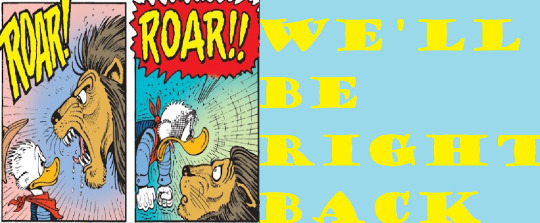
As for why Rosa set the chapter here there’s two simple reasons: it was one of two gold rushes mentioned in Barks work, meaning Scrooge could get in some more experience before making his fourtune in the Klondike, and Rosa understandably couldn’t resist having Scrooge and his greatest rival meet in their youth. He WAS careful to not have Scrooge learn Flinty’s name, as Scrooge dosen’t recognize him in Flintheart’s first apperance in “The Second Richest Duck”.. but Rosa noticed Flinty seemed familiar with SCROOGE, and simply ran with it, still having his first encounter with the bastard deeply effect Scrooge but leaving Scrooge unaware that the thief and betrayer he met in the Transavaal was the same heartless Scoundrel he’s fated to keep fighting till one or both of them keels over.
So starting the chapter proper Scrooge has come to the Transvaal to prospect for gold, following his hunch from last chapter, trying to make his way to the rand, a large natural area in south Africa. The Transvaal itself was a large expanse that was cut up in the 90′s after the fall of apartheid.
Scrooge passes a massive Diamond Mine, large with tons of miners on small claims, but wisely passes it up: there’s too many people, too much fuss and likely too much risk of getting stolen or finding nothing.
And to prove that point we meet Flinty who is trying to steal a guy’s diamonds for the second time today. Now the other miners reaction IS FAIR: they send him up in a bucket thing their using to transport the diamonds as a thief and announce him as such and the people on the surface’s reaction makes it very clear this isn’t new behavior. Him being punished is fine... their punishment though....
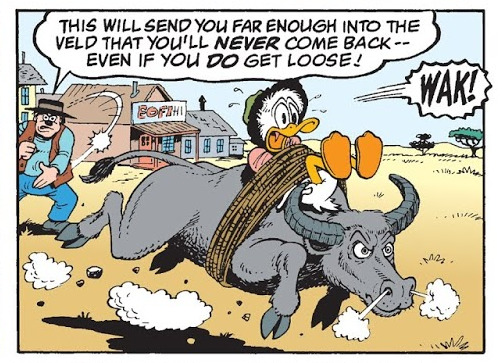

Seriously, theft is not worth doing a murder.. and yes he COULD escape and their trying to frame it like that’s not what htier doing.. but their sending someone with clearly low self preservation skills into the desert, with no suplies, tightlyt ied to an angry and clearly wild animal. While Flinty DOES deserve jail for his shit, he doesn’t deserve to DIE for attempted theft. He didn’t ruin anyone’s lives or actually succeed and he’s clearly harmless if eveyrone in the mine knows he’s a criminal. You can’t just murder all your problems away... I mean the blood alone is just not worth the clean up.
Naturally Scrooge crosses paths with Glomgold and assumes he’s simply gotten himself trapped somehow and being an openly kind soul at this point in his life, gladly helps the guy free. Scrooge mentions he’s headed to Johannesburg and GLomgold offers to come along and do all the work as his guide. Scrooge being Scrooge refuses the “do all the work part” but gladly accepts a guide and a new friend and introduces himself as from Scotland. And as a result we get... something resembling a joke...


Look I’m not against a good pun... but that was not a good pun. It wasn’t even a passable pun. It also feels like a bit of a stretch given Scrooge is well traveled by now. you’d THINK he’d get that he was probably talking about something local and not insulting himself.
So Scrooge talks about all he’s learned with Flintheart bored and kind of a dick.. and offering a lesson of his own despite being the same age as Scrooge.. specifically he takes first watch and gives a smug speech.
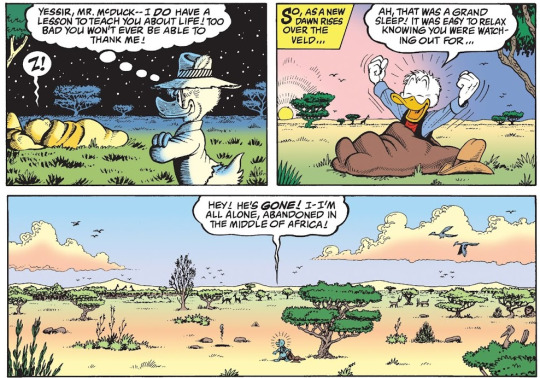
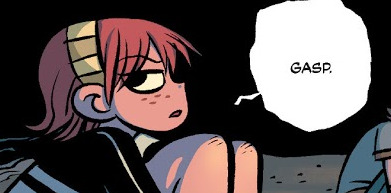
Scrooge wonders around the wilderness and finds a lion.. then an elephant and soon has the entire savannah after him as he bemoans the betrayal, having never felt like this. We’ll get more into the why in a bit. The point is he’s backed against a wall..but as we all know a cornered animal, human , duck , humanoid duck no matter the species is often at it’s most dangerous.

Especially if that animal is a McDuck. So here we get that badassery I mentioned: faced with an angry horde of some of the most dangerous and awe inspiring critters in Africa Scrooge uses EVERYTHING he’s learned roping cattle and what not to best them. He uses tricks from besting Long Horns to get the Elephants tangled up in a tree, then uses a log to beat a Rhino, before lassoing himself a motherfucking giraffe:

And if THAT weren’t already cool as all hell he tops himself: Since he dosen’t consider a Zebra a proper mount.. he decides to go for something bigger.
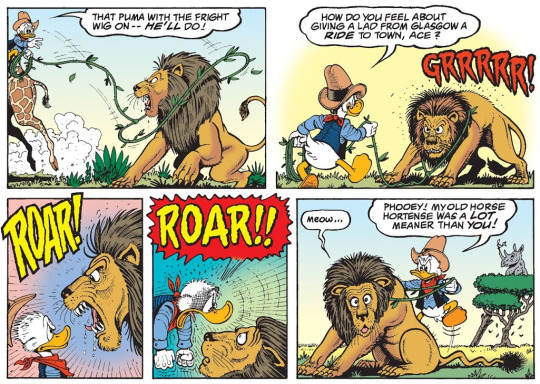
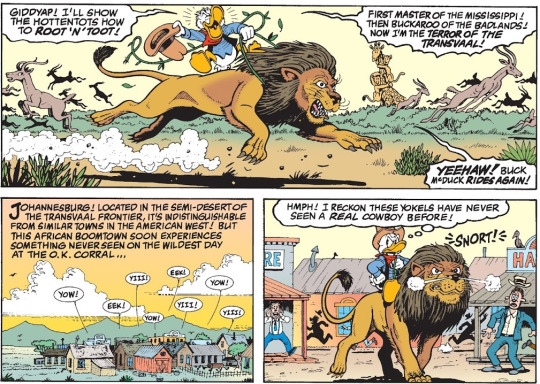
So to recap just so it all sinks in for you: Scrooge, abandoned with no suplies, defeats two elephants and a rhino, rides a Giraffe, then TAMES a fucking lion with nothing more than an improvised lasso and PURE RAGE. Then RIDES that majestic creature across the planes like a GODDAMN HORSE, before riding iti into town casual as all hell. I MEANT IT and he’s STILL not done. I mean it doesn’t’t top riding a motherfucking lion, what could, but what he does for an encore is still utterly badass and is a nice coda to riding a motherfucking lion.
So at the local abr Glomgold lies about everything and makes himself the hero of the story, Yes Flintheart Big Dick Glomgold. Purest soul there ever was. This lasts all of a minute as while Flinty brushes off the fact a cowboy is looking for him, he doesn’t even know what that is... he’s soon rightfully shitting himself when Scrooge comes for his vengeance.
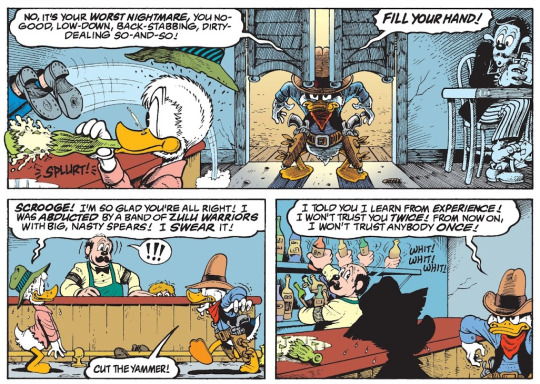
The art here is as always impeccable. The shading alone. But seriously I’m terrified and I know he can’t harm me... in theory. In practice if ANYONE could reach out of the page and throttle me, it’d be the guy who rode a motherfucking lion. And no i’m never letting that go. Fucker rode a lion. That’s the kind of thing you never forget about a character for damn good reason. We also get one of my favorite lines in the story, and it has tons of greats.. but this is an easy contender for my favorite:
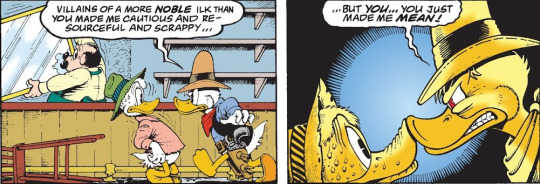
It’s a chilling line and panel, with it made clear Scrooge’s cynsim, his biggest weakness and often what makes him the most unlikable came from this.. the moment where a villain with no scruples, no care and no code or morals of any kind utterly betrayed him and tried to leave him for dead that took any scrap of hope in mankind he had and destroyed it. From now on he likes nobody and nobody likes him. Other mentors helped Scrooge grow as a person, taught him skills and taught him to survive, to enjoy the road getting to fortune as much as the fortune himself, and to make his way square. Flinty. just made him mean.
But Scrooge isn’t going to kill him.. for one thing he doesn’t’t like shooting people or animals. For another.. he has something far more satisfying in mind: Old West Justice, Tar and Feathearing style, covering the guy and humiliating him by making him do a bullet dance Marty McFly style.
Flinty TRIES to simply escape and steal Scrooge’s shotgun.. but it fails as he runs into the lion and Scrooge takes the beaten flinty over to the jail to press charges. Flinty is jailed.. and makes his own vow.
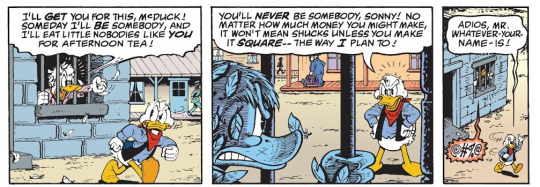
So with that Scrooge has made a foe for life, and this is another thing the 2017 Cartoon took.. it’s just where as this Flinty was merely angry at his rightful compuance and humilation, the cartoon one was a small child who swore vengance for an honest mistake. But either way you slice it he won’t make Scrooge’s life any easier.
So with that we get our epilogue: Scrooge never made his forutune her, naturally, as the ore was too low quality for him to process alone so only the already rich could afford to set up shop here. Scrooge packs it in determined to still make his fortune and we get an awesome closing panel.
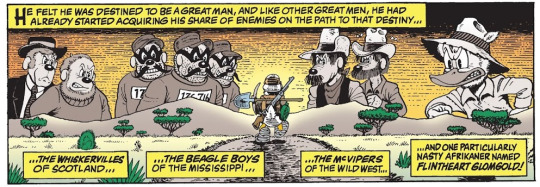
Final Thoughts: As you could probably tell, I fucking love this one. It’s utterly amazing. Barks himself has said he felt the best chapters took place over a short time span and it shows: by having to cover less time, only having a time passing bit at the very end, it allows this vital story to take place over less than a day and allows it to move at a hell of a pace. It’s got action, great character work as we see Scrooge’s last bit of trust in his fellow man shatter, and THE best climax of the series. And the others have some whoppers. This one is just so damn awesome, taking most of the issue but using EVERY page of it to tell one epic finale, from Scrooge’s easy mastery of the beasts, to his taming a motherfucking lion, to Flinty’s UTTERLY satstifying humilation conga...this is just a masterpiece and a huge reminder why I love this comic
Next Time: Scrooge sadly dosen’t keep the lion but does head to Australia where he faces what he is in the dark, meets a new mentor, and gets pointed to his destiny. See you next month for that.
If you liked this review share it, and if you’d like to help me make more join my patreon at patreon.com/popculturebuffet. WIth only 10 days left till the new pay period nows the time to jump in so you can pick a short for my Donald Duck birthday specail next month or help me reach a stretch goal so I can get it on the board. Time’s a wastin. And if you can’t, tha’ts fine, thanks for reading.
#the life and times of scrooge mcduck#scrooge mcduck#don rosa#the terror of the transvaal#flintheart glomgold#south africa#comics#disney#vengance
19 notes
·
View notes
Text
A hero in her own mind... On Daenerys Targaryen (part 5)

This post is a continuation of my analysis of Daenerys Targaryen’s narrative arc in Game of Thrones (Part 1, Part 2, Part 3, Part 4). Like the previous post, the focus is on her season 6 arc, which I’ve had to break up into several separate parts due to length. Season 6 marks a crucial moment in Daenerys’ journey and there are a lot of things to unpack from her scenes.
DRAGON AND CONQUEROR
In the last post, I said that Daenerys burning down the Dosh Khaleen marked a symbolic rebirth for her. A rebirth that visually underscored her alignment with the elemental power of fire; an alignment she shares with her dragons, as they are Fire made Flesh. Thus, Daenerys the Dragon was awoken in the fires of the Dosh Khaleen. She is fiercer now, more ruthless and more determined than ever to do whatever it takes to reach her goal.
This becomes apparent in a scene from episode 6 where Daenerys are leading her new and improved Khalasar towards Meereen through a desert landscape. She discusses her plans for tavelling to Westeros with Daario, who says that “you weren’t made sit on a chair in a palace. You’re a conqueror Daenerys Stormborn”. I find this line interesting because it makes a distinction between conquering and governing. Daario is paying Dany a compliment but at the same time it reads as a bit of a backhanded one: she’s made for conquest, not governing. From his point of view it is absolutely a compliment because he doesn’t care about governing – he likes war and women. But Daenerys’ goal is not just conquest, it is also governing Westeros as its queen and she’s hasn’t been very successful in her attempts to govern Meereen.
This dialogue, however, isn’t the most important part of the scene but rather what follows after their little exchange. Dany stills her horse, sits quietly, scanning the landscape – as if she is sensing something that others cannot. Then she tells them to wait as she rides ahead alone. Daario and the khalasar wait. The horses become restless. Then we hear a loud shrieking and we see the shadow of a dragon gliding over the hills of yellow stone that surrounds the khalasar. Drogon flies into frame as the music swells triumphantly. Drogon lands before the men and we see Daenerys is sitting astride him, in complete control. Then she proceeds to give a motivational speech to her new khalasar.
youtube
What is important about this scene? Firstly, this scene establishes that Dany now has complete control over her Drogon, the most difficult of her dragons. Throughout season 4 and 5, she found it increasingly hard to control Drogon, to the point that he simply left her and ranged over various parts of Essos (Tyrion saw him in the ruins of Old Valyria). She had never ridden him until the last episode of season 5 and that only came about because of a state of emergency. Drogon was uncooperative when they landed in the Great Grass Sea. She couldn’t get him to obey her. Now Daenerys is in complete control of her dragon. She rides Drogon as if it is the most natural thing in the world – and she has a special bond with him. This is a demonstration of her power – a power that is every bit as otherworldly as walking unharmed out of a flaming inferno.
Then there’s the speech. Why include a motivational speech at this point in her narrative? The start of this scene has already established that the Dothraki now follow her and that she has decided to pursue her goal to conquer Westeros rather than continue to govern Meereen. On the surface of things, this speech offers no new information. However, I would argue that this scene has a very specific function in relation to the audience – and that it should be interpreted from a Doylist rather than a Watsonian perspective. That is, what is important about this scene is how it presents Daenerys and her ambitions to the TV audience.
This scene can be somewhat tricky to decode because it is, in a sense, a wolf in sheep’s clothing. It presents itself as a conventional variation on The Rousing Speech Trope, which is a standard element in epic cinema, be it fantasy, period or action movies. This scene, however, isn’t standard at all. Rather, it inverts the trope but you have to pay close attention and you have to be conversant with the conventions of the trope. In order to spot the inversion of the trope, it is necessary to compare Daenerys’ speech with a couple of straightforward examples of the trope.
One of my favorite examples of The Rousing Speech Trope is from Lord of the Rings: The Return of the King (2003), where Aragorn gives heart to the soldiers before the Battle of the Black Gate in Mordor where they face overwhelming odds. It is a rather poetic speech and Viggo Mortensen is completely on point with the delivery. Interestingly enough, this speech is not from Tolkien’s books but an invention of the screenwriters. The reason for this invention can most likely be found in the conventions of the epic cinema. A rousing speech given by the hero before the final battle is standard operating procedure when it comes to this genre.
youtube
“Friends of Gondor, of Rohan – my brothers! I see in your eyes the same fear that would take the heart of me. The day may come when the courage of Men fails; when we forsake our friends and break all bonds of fellowship; but it is not this day – an hour of wolves and shattered shields, when the Age of Man comes crashing down – but it is not this day!!! This day we fight! By all that you hold dear on this good earth – I bid you stand! Men of the West!”
Another favorite of mine is the bastardized and altered version of Elizabeth I’s famous Tilbury Speech that Cate Blanchett delivers in Shekar Kapur’s Elizabeth: The Golden Age (2007).
youtube
“My loving people! We see the sails of the enemy approaching. We hear the Spanish guns over the water. Soon now, we will meet them face to face. I am resolved in the midst and heat of the battle to live and die amongst you all! While we stand together, no invader shall pass. Let them come with the armies of Hell! They will not pass! When this day of battle is ended, we will meet again in heaven… or on the field of victory!”
This scene is both visually and dramatically effective – with a flame haired Elizabeth who has donned armor like a latter-day Joan of Arc. Sitting a white horse, she is a dramatic sight as she delivers her rousing speech. However, this speech bears little resemblance to the original and very famous speech that Elizabeth I delivered at Tilbury in July 1588. Only a few lines from the original speech has been included (highlighted in black). Why is that? Elizabeth I’s Tilbury speech is very famous but it doesn’t really conform to genre conventions. It was written several centuries ago and thus it may not appeal to a modern audience.
The Rousing Speech Trope is most often deployed before a battle of some kind. (Top 10 Battle Speeches). The situation is dire, our heroes are on the defensive and the odds are overwhelming. Then the hero makes a speech to rally his men, reminding them of what they’re fighting for, etc. The music swells triumphantly as the soldiers cheer and then they are ready to fight. Such is the standard structure of a scene where this trope is used. What is particularly interesting about these speeches is the use of words such as we, us and our. The function of such a speech is to create a sense of fellowship, to create unity in the face of adversity. The aim is to stand united against a common foe by remembering the things that are worth fighting for, even worth dying for, whether that be family, country, freedom or even mankind itself. Within the narrative, the function of Rousing Speech is to give heart to the soldiers who are about to fight. However, such a speech can also evoke strong emotions in the audience and serve as a reminder of what we hold dear. Interestingly enough, the Rousing Speech Trope is almost always used in situations of defense. It is about motivating people to defend something precious. This is a very important point to keep in mind when we take a look at the speech Daenerys gives to her khalasar.
The scene with Dany’s speech to the Great Khalasar has roughly the same structure as most examples of The Rousing Speech Trope. However, the language and the message are quite different:
“Every khal who ever lived chose three blood riders to fight beside him and guard his way. But I am no khal. I will not choose three blood riders. I choose you all. I will ask more of you than any khal has ever asked of his khalasar. Will you ride the wooden horses across the black salt sea? Will you kill my enemies in their iron suits and tear down their stone houses? Will you give me the Seven Kingdoms, the gift Khal Drogo promised me before the Mother of the Mountains? Are you with me? Now and always?”
There is no real unity in this speech. Note how the key words: we, us and our aren’t present at all! Dany presents herself as an extraordinary ruler to the Dothraki – a Khal of Khals, so to speak. She asks a number of rhetorical questions? Questions that she doesn’t need any answer to. They just serve to rile up her troops into a frenzy. There is no us, no we; only you and I – there is no true fellowship between Dany and her army, only ruler and subject. She asks them to serve and they will serve her by giving her what she wants through violence. Daenerys paraphrases Drogo’s speech from season 1 (episode 7), leaving out the more unsavory bits about rape and slavery – though these things are not mentioned, neither are they expressly forbidden. It is understood that slaughter, pillage and rape will happen when she unleashes the Dothraki upon Westeros.
This speech highlights just how ruthless Daenerys has become in pursuit of her goal, especially when you compare it to the discussion she had with Jorah Mormont and Barristan Selmy when she arrived in Astapor in season 3 (episode 1). That was when she needed an army – and the reason she chose to acquire an army of Unsullied was because she didn’t want innocents to suffer in her war of conquest. She made that decision based on these words by Jorah Mormont:
“There’s a beast in every man and it stirs when you put a sword in it. But the Unsullied are not men. They do not rape. They do not put cities to the slaughter unless they are ordered to do so.”
The Daenerys of season 6 is a far cry from the kind-hearted young woman who was moved by the plight of innocents in season 3. That woman couldn’t bear the thought of her armies raping and pillaging their way through Westeros. Now she’s ready to unleash an army of Dothraki, whose entire culture appear to revolve around slaughter, rape and pillage! She may have told Yara Greyjoy that the Iron Islands has to stop reaving but she didn’t forbid the Dothraki their wartime “traditions”. Daenerys has definitely stepped onto a darker path and she is willing to compromise her own moral integrity to put her backside on the Iron Throne.
Since season 5 I have started to doubt whether Daenerys is supposed to be a hero in this story. She is undoubtedly one of the protagonists and she has done a number of remarkable things. Her crusade against slavery is a noble cause but the brutal way she handles opposition makes me wonder about her abilities as a ruler. So far, her intentions have been good but the road to Hell is often paved with good intentions. However, conquering a country because she thinks it is her birthright is a matter that very different from ending a cruel and inhumane system such as slavery. Daenerys’ quest for the Iron Throne is not an altruistic one. It is a selfish one – and the price will be paid by the people of Westeros.
He fiery “rebirth” marks a crucial change in Daenerys – a much more ruthless woman has emerged from the fire – and I think that her character is stepping onto a much darker path that may very well eclipse the heroic image she has enjoyed so far. This is the reason why I think the showrunners chose to write a scene for Dany that is typical for a traditional hero but where the significant part is the complete opposite of heroic. It is a speech that announces a war of aggression, not a speech that builds unity in the face of a stronger enemy – and heroes generally don’t preach slaughter and destruction in pursuit of conquest.
Incidentally, Jack Bender who directed this scene has some interesting thoughts on this particular subject:
“At the end of the scene, you should be somewhat roused by her and a little horrified. […] She’s not Hitler at Nuremberg, but she’s got the power.” (x)
The comparison to Hitler may be rather tasteless but Bender has a point. He articulates it better in an interview with Vulture:
“Historically, there are echoes of that kind of speech, seeing that kind of fervor for that kind of leader. Power is a seductive thing, and you have to decide whether to use if for good or bad. Every great leader has to know how to wield that sword, and she certainly has the charisma and power to get them back to her. Where it goes from here, who knows.” (x)
In this context, I find it very interesting that it is in season 6 that the show really begins to compare and contrast Jon Snow and Daenerys Targaryen in their roles as leaders. Until now, they have been on parallel journeys but now we begin to see the contrasts between them – and there are some very striking contrasts indeed. In my previous post, I noted the worshipful attitude the Dothraki exhibit towards Daenerys when she emerged unburnt from the fires of the Dosh Khaleen. Jon was met with a similar awestruck attitude when he emerged after his resurrection. But where Dany accepts and revels in the worshipful adoration, Jon quietly rejects it. When Tormund says “They think you’re some some kind of god, Jon simply answers: “I’m not a god” (episode 3).
Even the way the two scenes are shot reveals some interesting contrasts. When Dany exits the fire she remains standing on the steps that lead up to the burning building. There she stands while all the Dothraki prostrate themselves before her. When Jon emerges from the room where he had lain dead, Wildlings and Black Brothers stand in the courtyard of Castle Black, looking up at him. He descends the steps and walk among the men and he quietly defuses the awestruck atmosphere through his interactions with Tormund and Edd.
A similar comparison can be made between Jon and Dany with regard to the manner in which they recruit the Wildlings and the Dothraki to their causes respectively. I’ve already conducted an analysis of how Dany riles up the fervor of the Dothraki with a speech about killing her enemies. Jon Snow goes about his business in a markedly different manner (episode 7).
youtube
Jon Snow asks the Wildlings for their help – then he steps aside and let their leaders debate the question. When he steps into the debate, he stresses that they all need to stand together against the common enemy. The way the two scenes are filmed is also striking: Dany sits atop a huge dragon and looks down on the Dothraki whilst shouting at them whereas Jon is placed on equal footing with the rest of the Wildling leaders. He isn’t even in the centre of the shot – all of them actually stand in a circle! The difference between the two leaders couldn’t be more stark (pun intended). Daenerys secures the loyalty of the Dothraki through shock, awe and sheer charismatic presence whereas Jon secures the Wildlings through earnest cooperation and common goals. Both are strong leaders – but there’s a difference between military victory and governance, and strong military leaders are not necessarily good rulers.
235 notes
·
View notes